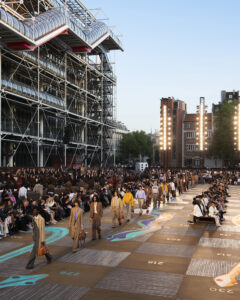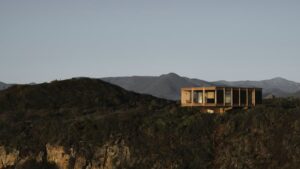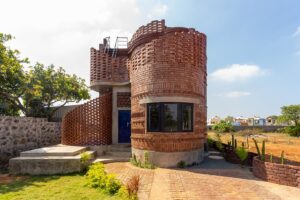What Is Speculative Realism and How Can It Revolutionize Architecture—Architects worldwide are being inspired by philosophy to take on some of the most significant challenges of our time
▎At the heart of our built environments lies a deep-seated human-centric philosophy, a legacy of architectural traditions that predominantly focus on human utility and experience. However, in the face of escalating environmental crises and a growing recognition of our entwined fate with the natural world, a radical shift in architectural practice has taken place.
This shift, inspired by the philosophical movement known as speculative realism, challenges the foundations of traditional architecture. As architects and designers grapple with the realities of climate change, biodiversity loss and sustainability, speculative realism offers a timely and compelling framework. It encourages a departure from designing solely for human needs towards a more holistic approach that considers the ecological and ethical dimensions of our built environments.
The thinking of philosophers Quentin Meillassoux and Graham Harman are instrumental in the discussions surrounding speculative realism. Their philosophical underpinnings have enabled and shaped a new architectural ethos. Meillassoux’s argument for an “ancestral” reality and the idea that the world doesn’t revolve around human existence and understanding, alongside Harman’s advocacy for an object-oriented ontology, presenting that each object in the world, from a human being to a rock, has its own equally valuable existence and significance, encourages a profound reevaluation of how we design and interact with our land and spaces — advocating for a reality where architecture acknowledges and values the existence and agency of non-human elements as staunchly as it does for humankind.
In recent years, with the rapid technological advancements of the modern age, we have begun to see the practical manifestations of this previously theoretical thinking taking shape. Moving beyond the philosophical foundational principles laid out by thinkers like Meillassoux and Harman, architects are beginning to actualize these ideas in real world designs. These new architectural endeavors represent a profound departure from traditional norms, embodying a way of designing that values the interconnectedness of all life forms and accepts that there is much we still do not understand about other life on the planet, and therefore, we should value and safeguard it as we do our own.
SAWA in Rotterdam stands as a testament to this new ethos. The circular project by Mei, illustrative of speculative realism, brings to life a design that combines human needs with ecological integrity without the assumption that the human need is greater. Here, the timber structure is not an imposition on the landscape but a facilitator of increased biodiversity, sustainability, and environmental stewardship. The project integrates nesting boxes, planters, terraces, and towers in a way that is both aesthetically pleasing and nature-inclusive to create a habitat that is sustainable and intimately connected to the fabric of the natural world.,
Architects committed to the principles of speculative realism (even if they don’t call it by this name) often articulate a vision of sustainability that extends beyond conventional green building standards. They envision a future where architectural practice is deeply entwined with environmental ethics. This perspective involves a comprehensive lifecycle analysis of building materials, focusing not just on their immediate environmental impact but also on their long-term implications for the planet. They advocate for a cradle-to-cradle design philosophy, which encourages building components that can be fully recycled or repurposed at the end of their life, thereby reducing waste, promoting a circular economy and supporting life on earth for further millennia, not merely centuries.
In their quest for sustainable innovation, these architects are exploring the use of advanced materials that have a reduced ecological footprint. For instance, graphene-based paints and coatings represent a cutting-edge development; these materials can potentially transform buildings into energy-generating entities, capturing solar energy more efficiently than traditional solar panels. Similarly, the use of mycelium-based materials for insulation and structural components is pushing forward. Mycelium, the root structure of fungi, can be grown into custom shapes and is biodegradable, offering a sustainable alternative to conventional insulation materials. Moreover, these materials provide excellent thermal and acoustic properties, enhancing the energy efficiency of buildings.
The exploration of bio-based construction materials is an exciting frontier. Engineered timber, for example, offers a sustainable and robust alternative to traditional building materials, reducing the carbon footprint associated with construction. Algae-infused building panels are being researched for their ability to capture carbon dioxide from the atmosphere, potentially turning buildings into large-scale carbon capture devices. This technology not only helps reduce greenhouse gas emissions but also improves air quality. Living walls and rooftop gardens contribute to air purification, temperature regulation and even biodiversity within urban landscapes. In buildings inspired by speculative realism, such features are common, offering a glimpse into a future where architecture and nature exist in a symbiotic relationship.
Speculative architecture often involves exploring futuristic and sometimes utopian concepts. The idea of ‘protopias’ — incremental progress towards a better future — has been discussed as an alternative to traditional utopian visions. This approach is seen as more practical and achievable, focusing on gradual improvements rather than radical transformations.
With this in mind, the emergence and integration of new technologies are vital for exploration and advancement. The rise of self-sustaining buildings, which are not only energy-efficient but also capable of managing their resources autonomously, is groundbreaking. As technology progresses, these buildings are envisioned to be equipped with AI-driven systems that can optimize energy consumption, water usage and waste management in real time. The AI systems can analyze environmental data, occupant behavior and building performance to continuously adapt and optimize resource use, making buildings more responsive to their inhabitants and the environment. Finding harmony for all can soon become an ever-evolving dialogue between human needs, technological possibilities and ecological integrity.
These advanced perspectives underscore the significant shift in architectural practice, a way of thinking and designing that is driven by a deep commitment to ecological responsibility and innovation. They reflect a growing consensus among architects that the buildings of the future must not only serve human needs but also contribute positively to the health and sustainability of our planet long after we are gone.
Om onvervangbaar te zijn, moet je altijd anders zijn.
Er zijn fascinerende beelden hier, en de fascinerende dag van samen! xo
─────────────────────────────────────────────────────
Per essere insostituibili bisogna sempre essere diverso.
Ci sono immagini affascinanti qui, e l’affascinante giornata di insieme! xo KanikaChic




















